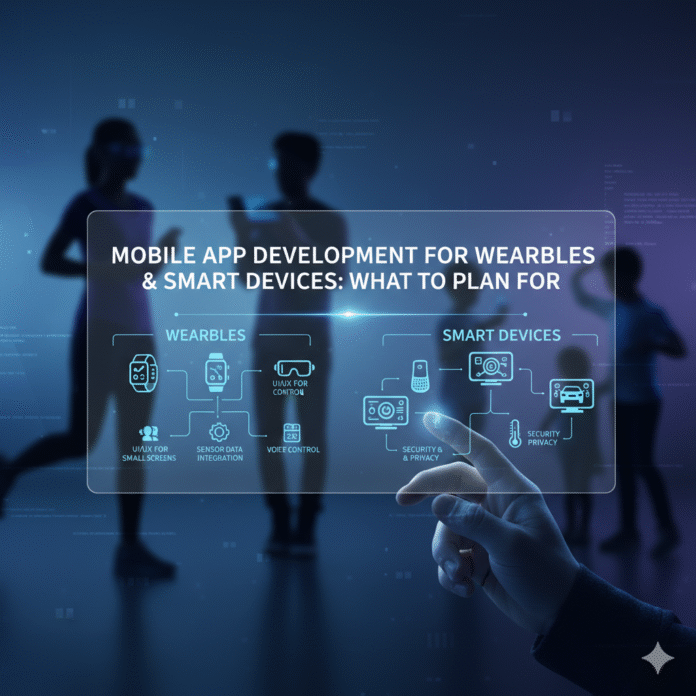The world of technology is getting smaller and smarter.
From smartwatches to fitness trackers and smart home devices — wearable technology is changing the way people connect with apps.
If you are thinking of developing an app for wearables or smart devices, this guide will help you understand what to plan for and how to make your app user-friendly, fast, and successful.
1. Understand the Wearable Ecosystem
Before you begin, it’s important to know which devices you’re building for.
Wearables include smartwatches, fitness bands, AR/VR glasses, and even health monitoring devices.
Each device has different features, sensors, and display sizes. Your app should match its purpose — whether it’s for tracking health, managing tasks, or offering notifications.
Tip: Start with one platform (like Apple Watch or Wear OS) before expanding to others.
2. Focus on Simplicity and Design
Wearables have limited screen space. That means your app’s interface should be simple, clean, and focused on quick actions.
Avoid long menus and unnecessary text.
Use larger icons, minimal gestures, and easy navigation.
Tip: Test the app in real situations — walking, running, or driving — to ensure it’s truly convenient to use.
3. Speed and Battery Efficiency Matter
Wearable devices run on smaller batteries. An app that drains power quickly won’t stay installed for long.
Keep your code light and avoid background processes that use constant resources.
Compress images and data whenever possible to reduce load times.
Tip: Optimize your app for performance using power-efficient APIs.
4. Secure the User’s Data
Wearables often collect sensitive personal data like steps, heart rate, or sleep patterns. That’s why security should be a top priority in development.
Use encryption, secure login methods, and get user consent before accessing any personal data.
Transparency builds trust — something every successful app development company focuses on.
Tip: Follow global standards such as GDPR and HIPAA if your app deals with health data.
5. Add Smart and Useful Features
Modern wearables rely on sensors, AI, and cloud connectivity.
Use these tools to make your app smarter and more interactive.
Examples:
- A fitness app that alerts users when they skip workouts.
- A smartwatch app that reminds users to drink water or stand up.
- A home control app that syncs lights or temperature automatically.
Tip: Add only features that genuinely improve user experience — not just to show off technology.
6. Test on Real Devices
Simulators are good for early testing, but nothing beats real-world experience.
Always test your wearable app on actual devices to catch design and performance issues early.
Ask real users for feedback before your official launch.
Even small changes can make your app smoother and more reliable.
Tip: Include usability testing for accessibility and comfort.
7. Work With a Professional Mobile App Development Company
Developing for wearables is not the same as developing a regular mobile app.
It requires experience with different SDKs, APIs, and design guidelines.
That’s why it’s smart to collaborate with a Mobile app development company.
They can guide you through the entire process — from idea to final launch — and ensure your app meets user expectations.
A reliable app development company also helps with ongoing maintenance and future updates as technology evolves.
8. Plan for Future Updates
Wearable technology is growing fast.
New devices and operating systems are released every year.
Plan for future updates so your app remains compatible and competitive.
Use scalable code and flexible architecture so you can add new features without rebuilding everything.
Tip: Stay updated with the latest wearable trends to keep your app relevant.
FAQs
Q1. Why are wearables important for app development?
Wearables bring your app closer to users by offering real-time, hands-free access to data and functions.
Q2. Can I use the same app for mobile and wearable devices?
Not exactly. You need a customized version for wearables with lightweight design and limited functionality.
Q3. How much does it cost to develop a wearable app?
Costs depend on features and platforms. A professional Mobile app development company can give you an accurate estimate after reviewing your requirements.
Q4. What technologies are used in wearable app development?
Common tools include Kotlin, Swift, Flutter, and frameworks like Wear OS SDK and WatchKit.
Conclusion
Wearable and smart devices are the future of connected technology.
To stay ahead, businesses should invest in apps that make life easier, faster, and more personalized.
Working with a skilled Mobile app development company can help you design innovative, secure, and efficient apps that fit perfectly into users’ daily routines.
Call to Action
Ready to turn your wearable app idea into reality?
Partner with a trusted app development company that understands both user experience and technology.
Start your project today — and bring your app to every wrist and smart device around the world!

